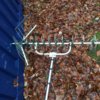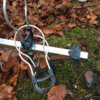@flameport has covered the basics. I'll fill in a bit of the detail.
Any DIYer can install an aerial. A fee will do a very good job because they spend the money and time to do it correctly. When that's factored, the DIY job cost more to do than having a pro do the work.
The biggest question with any DIY install is "What will it cost to put a bodged job right?"
For chimney installs, wrecked pointing causing water ingress is all too common where a poor bracket has been used or the bracket incorrectly installed. In the worst case I have seen, the cost to make good ran to several hundreds of £'s. This was because they needed a roofer to sort the chimney, then a builder to sort the wet and dry rot in the timber plus fix the damage to the ceilings and walls in two rooms. I know this all sound a bit doom and gloom, and I have to stress that this was an extreme case. However, the home owner thought that putting up an aerial was an easy job and didn't stop to consider that the bracket was too small for the size of aerial. Most times the bracket causes brickwork damage, it's just a bit of repoint in required if caught early enough. But how often do you get on the roof to check the pointing?
Regarding alignment; depending on the local field strength, there's anything from a 10 to 30 degree arc where an aerial will function. You can get this from simply pointing in the same general diection as the neighbours aerials, but it won't give acceptable results in most cases. The next stage is fine tuning down to a 1-2 degree arc. For that you'll need a meter if you're working solo.
The pocket aerial meters at £10-£15 are a waste of space. The metered range starts at too high a signal level, and the gradations are too large to provide anything but very coarse directional indication.
The supposedly semi-pro meters such as the Fringe Pro+ (approx £50) are more accurate, but they still only read an average of all the muxes. You might think "What's wrong with that?" and if all the muxes came in at the same power then an average meter would do just fine.
What you find in use though is that there's a variation in strength depending on the transmission power, and the frequency, and the alignment of the aerial. In the trade we call this 'Slope'. During an install, I might see anything up to a 6dB spread in signal power before the aerial direction is fine tuned. 6dB is the equivalent of halving the signal, then halving it again. That means the weakest mux can be just 25% of the power of the strongest.
My professional meter cost around £400, and it shows me a bar graph with each of the muxes represented. As I move the aerial, the levels change. My objective is to minimise the slope difference across the main muxes down to the lowest level. This might not be when the aerial is pointing directly at the transmitter.
Brackets: For low to medium wind loading aerial on a 2-3m pole then an 8" galvanised mitre cradle will generally be sufficient unless the site is in a very exposed location.
In summary then, yes a DIY install is possible. However, paying a professional could work out cheaper, and certainly quicker, and most likely with with better results, too.
If this or any other reply was helpful to you, on each one please press the THANKS button which appears when you hover the mouse pointer near the Quote Multi-quote buttons.





